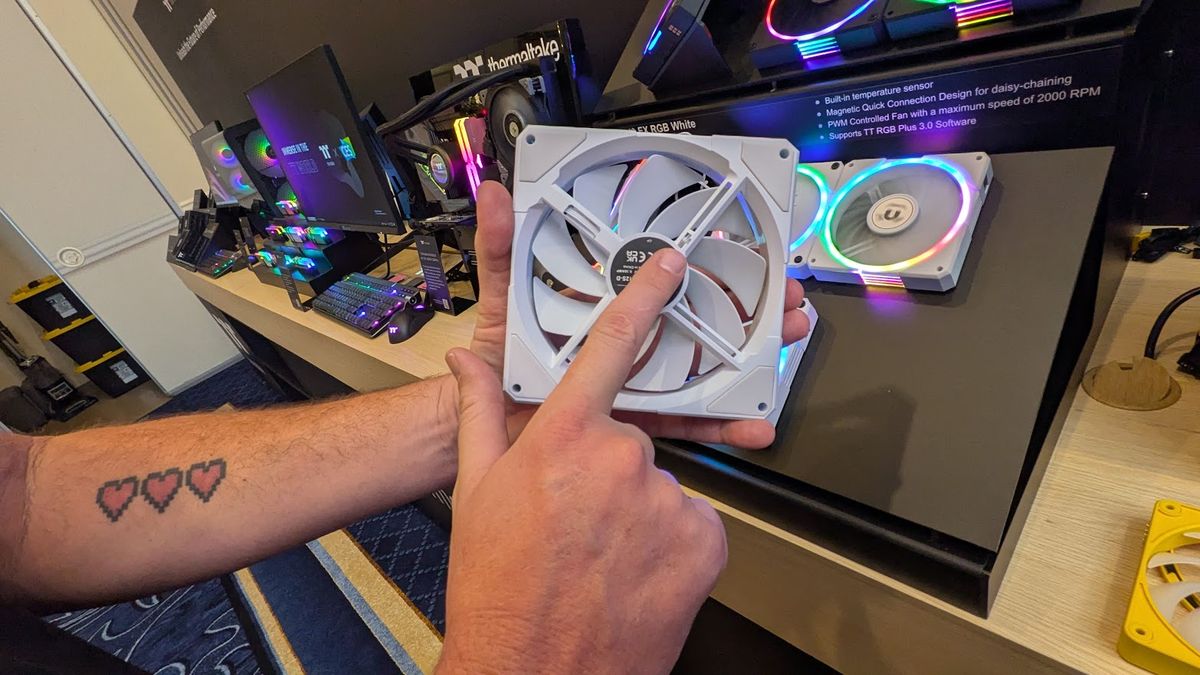Thermaltake's new case fan has built-in temperature sensor to help adjust its speed
The TS120 / TS140 fans start at $89 for a set of three.

Whether they are controlled by your motherboard or by a dedicated controller, your PC's case fans cycle up and down based on how hot the control software thinks your computer is. The problem: most computers get temperature and usage readouts for the CPU and GPU, but not for the exact area where your case fans live. You might have case fans that are very far away from your hottest components and perhaps they could be spinning less (or more) based on the temperature on the top of your case or the front or the bottom.
Thermaltake's new TS120 and TS140 case fans are the company's first to have built-in temperature sensors which allow each one to know exactly how hot or cold it is in that section of your case. Then the upcoming TT Plus RGB 3.0 software will allow you to view the temperatures and control the fan curves, presumably (though this hasn't been confirmed) on a fan-by-fan basis.


Due out in Q1 for $89 for a pack of three 120mm fans or $94 for three of the 140mm, the TS120 and TS140 aren't the very first case fans to have built-in temperature sensors. We believe that honor goes to Corsair, whose QX120 fans debuted in 2023. However, Thermaltake's fans will be selling for about $40 less, even at their MSRP and integrate nicely with the brand's rich ecosystem of coolers, cases and peripherals.
The TS120 / TS140 snap together using MagForce 2.0, a magnetic connection that makes them easy to put in rows together. Available in black or white, they have rich ARGB rings around the fan itself, along with stacked sets of RGB lines on each side. Each set of three connects to a dedicated controller. The fans run at a maximum speed of 2,000 rpm.
I had a chance to see the TS120 / TS140 fans at Thermaltake's CES 2025 booth and I was both impressed by their bold looks and their advanced functionality. Being able to set temperatures by-the-fan is a recipe for both cooler temperatures and a quieter system overall.
Stay On the Cutting Edge: Get the Tom's Hardware Newsletter
Get Tom's Hardware's best news and in-depth reviews, straight to your inbox.
-
Notton In fact, this idea existed all the way back in 2003.Reply
Antec had their SmartCool fans
Thermaltake had their A1357 Smart Case fan
There were a few other designs.
Despite their name, they didn't have complex circuitry, only a temperature sensor hooked up to a rheostat. It, take a guess, changed fan speed based on heat where the sensor was placed.
All of this was passive, so you didn't need to rely on software to change the speeds.
And then they faded away because changing fan speed based on CPU temp became a thing. -
thestryker Given the focus on airflow for cases currently I think a lot of people have set either static fan speeds or narrow RPM windows to minimize noise levels. I could see the benefit to a temperature sensor like this reading from exhaust which controlled all other case fan speeds based on those readings.Reply
That being said I'd be much happier if it was a hardware solution rather than software. I'd certainly pay for a fan controller which could have profiles stored to it directly and pull temperature readings from one source and apply the fan profile to all if it meant setup with software and then self managed from there. -
closs.sebastien I don't understand the point of this product.. All fans are already managed by the mainboard, with many customizable profiles...Reply
and the mainboard has already temp-sensors a bit everywhere....